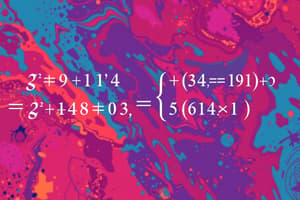Podcast
Questions and Answers
What are variables in algebra and why are they important?
What are variables in algebra and why are they important?
Variables are symbols, often letters, that represent numbers and are important for expressing general mathematical relationships.
Explain the difference between an equation and an expression.
Explain the difference between an equation and an expression.
An equation is a mathematical statement asserting the equality of two expressions, while an expression is a combination of variables, numbers, and operations without an equality sign.
What does it mean to factor an expression, and give an example?
What does it mean to factor an expression, and give an example?
Factoring an expression means breaking it down into simpler components that, when multiplied together, produce the original expression, e.g., $x^2 - 9 = (x - 3)(x + 3)$.
Define what perimeter is and how it is calculated for a rectangle.
Define what perimeter is and how it is calculated for a rectangle.
Describe the concept of complementary angles.
Describe the concept of complementary angles.
How is the area of a circle calculated?
How is the area of a circle calculated?
What is the relationship between multiplication and division in terms of repeated operations?
What is the relationship between multiplication and division in terms of repeated operations?
What defines a 3D shape and how is its volume calculated for a cube?
What defines a 3D shape and how is its volume calculated for a cube?
Flashcards are hidden until you start studying
Study Notes
Algebra
-
Definition: Branch of mathematics dealing with symbols and the rules for manipulating those symbols.
-
Key Concepts:
- Variables: Symbols (often letters) used to represent numbers.
- Expressions: Combinations of variables, numbers, and operations (e.g., 3x + 2).
- Equations: Mathematical statements asserting equality (e.g., 2x + 3 = 7).
- Functions: A relation between a set of inputs and a set of possible outputs, often expressed as f(x).
-
Operations:
- Addition/Subtraction: Combining or removing numbers.
- Multiplication/Division: Scaling numbers, with multiplication being repeated addition and division being repeated subtraction.
-
Key Methods:
- Factoring: Breaking down expressions into simpler components (e.g., x² - 9 = (x - 3)(x + 3)).
- Solving Equations: Finding the value of variables that make the equation true.
- Inequalities: Expressions that show the relationship between quantities that are not necessarily equal (e.g., x > 5).
-
Applications:
- Used in various fields such as physics, engineering, economics, and computer science.
Geometry
-
Definition: Branch of mathematics concerned with the properties and relations of points, lines, surfaces, and solids.
-
Key Concepts:
- Points: Basic units; no size, only a position.
- Lines: Straight, extend infinitely in both directions, defined by two points.
- Planes: Flat surfaces extending infinitely in two dimensions.
-
Shapes and Figures:
- 2D Shapes: Squares, rectangles, circles, triangles, etc.
- Perimeter: Total distance around a shape.
- Area: Space enclosed within a shape (e.g., Area of a rectangle = length × width).
- 3D Shapes: Cubes, spheres, cylinders, pyramids, etc.
- Volume: Space occupied by a 3D shape (e.g., Volume of a cube = side³).
- 2D Shapes: Squares, rectangles, circles, triangles, etc.
-
Angles:
- Types: Acute (<90°), right (90°), obtuse (>90°).
- Complementary Angles: Two angles that add up to 90°.
- Supplementary Angles: Two angles that add up to 180°.
-
Theorems:
- Pythagorean Theorem: In a right triangle, a² + b² = c², where c is the hypotenuse.
- Parallel Lines: Lines that never meet; angles formed with a transversal have special relationships (corresponding, alternate interior).
-
Applications:
- Used in art, architecture, engineering, and various fields that require spatial understanding.
Algebra
- Algebra is a branch of mathematics that involves symbols and the rules for their manipulation.
- Variables are symbols, often letters, representing numbers that enable mathematical expressions.
- Expressions are combinations of variables, numbers, and operations, such as 3x + 2.
- Equations are mathematical statements asserting equality, like 2x + 3 = 7.
- Functions represent a relationship between inputs and outputs, commonly noted as f(x).
- Basic operations in algebra include addition and subtraction for combining or removing numbers, and multiplication and division for scaling, where multiplication is repeated addition and division is repeated subtraction.
- Factoring involves breaking down expressions into simpler components, exemplified by x² - 9 = (x - 3)(x + 3).
- Solving equations aims to find variable values that make an equation true.
- Inequalities express relationships between quantities that are not equal, such as x > 5.
- Algebra has applications in physics, engineering, economics, and computer science.
Geometry
- Geometry is focused on the properties and relations of points, lines, surfaces, and solids.
- Points are the fundamental units in geometry and possess no size, only location.
- Lines are straight entities extending infinitely in both directions and are defined by two points.
- Planes are flat surfaces that extend infinitely in two dimensions.
- 2D shapes include squares, rectangles, circles, and triangles; calculations involve perimeter (distance around the shape) and area (space within the shape, such as length × width for rectangles).
- 3D shapes encompass cubes, spheres, cylinders, and pyramids, and their dimensions are measured by volume (space occupied, like side³ for cubes).
- Angles are categorized as acute (less than 90°), and supplementary (add to 180°) or complementary (add to 90°).
- The Pythagorean Theorem is foundational for right triangles, stated as a² + b² = c², where c is the hypotenuse.
- Parallel lines do not intersect and have specific angle relationships when crossed by a transversal (corresponding and alternate interior angles).
- Geometry is essential in art, architecture, engineering, and any discipline that requires a spatial understanding.
Studying That Suits You
Use AI to generate personalized quizzes and flashcards to suit your learning preferences.




